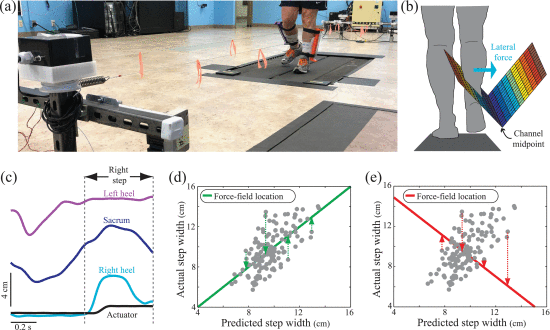
Motion of the pelvis throughout a step predicts step width during human walking. This behavior is often considered an important component of ensuring bipedal stability, but can be disrupted in populations with neurological injuries. The purpose of this study was to determine whether a novel force-field that exerts mediolateral forces on the legs can manipulate the relationship between pelvis motion and step width, providing proof-of-concept for a future clinical intervention. We designed a force-field able to: 1) minimize the delivered mediolateral forces (Transparent mode); 2) apply mediolateral forces to assist the leg toward mechanically-appropriate step widths (Assistive mode); and 3) apply mediolateral forces to perturb the leg away from mechanically-appropriate step widths (Perturbing mode). Neurologically-intact participants were randomly assigned to either the Assistive group (n = 12) or Perturbing group (n = 12), and performed a series of walking trials in which they interfaced with the force-field. We quantified the step-by-step relationship between mediolateral pelvis displacement and step width using partial correlations. Walking in the Transparent force-field had a minimal effect on this relationship. However, force-field assistance directly strengthened the relationship between pelvis displacement and step width, whereas force-field perturbations weakened this relationship. Both assistance and perturbations were followed by short-lived effects during a wash-out period, in which the relationship between pelvis displacement and step width differed from the baseline value. The present results demonstrate that the link between pelvis motion and step width can be manipulated through mechanical means, which may be useful for retraining gait balance in clinical populations.

